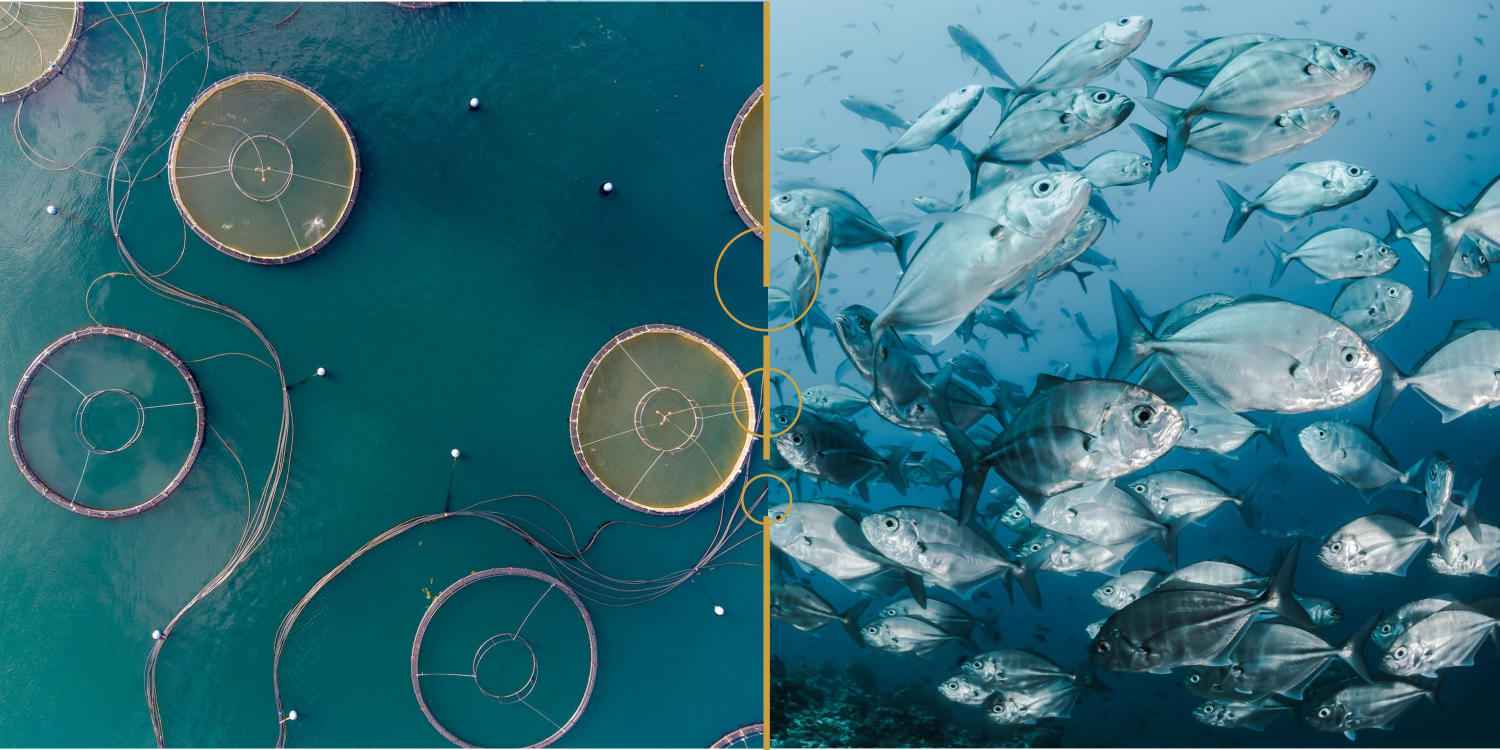
Farm-Raised Fish vs. Wild Caught: Pros and Cons
We are reader-supported. When you buy through links on our site, we may earn affiliate commission.
Farm-raised fish vs. wild-caught — which is better? Unfortunately, the answer is not so simple. The climate is changing, and the seafood industry is adjusting with it. Wild-caught fish may be more nutritious and support a more localized economy, but farmed fish provides a stable supply for a growing population. Comparing the two requires examining the social, economic and environmental impact of each.
Pros of Fish Farming
Some of the advantages of farm-raised fish include a more reliable supply of fish, and the ability to support various fish species in the same system. Fish farms are a rapidly growing industry, and there is considerable job growth to be considered. While fish farms historically have had a terrible toll on the environment, new technology and monitoring systems are advancing the way operations work.
1. Stable Supply
As wild fish populations dwindle due to climate change, fish farms may provide a more stable source of protein. Some certain species of farmed fish, like salmon, are genetically modified to grow more quickly and require less fish meal than non-modified types.
2. Species Diversity
The impact of the fish farm depends heavily on the species being farmed. Shellfish, high-protein fish like trout and salmon and herbivorous ones like tilapia and carp can all be farmed. In the United States, shrimp, Atlantic salmon and tilapia are the most produced species. Since many wild fish species also flourish in a farmed setting, farmed fish may provide population stability for threatened species.
3. Closed System
One of the biggest issues with farmed fish, environmental waste, may also be an advantage. Innovations in technology are helping fish farms reuse and remove water, often through recirculatory aquaponic systems that use microbes to clean the water.
4. More Monitoring
One advantage of fish farms is increased governance and policy. Since farmed fish has received a hefty dose of bad press, the aquaculture industry is working hard to make sustainable changes. New policies include carbon credits and sustainable certifications, holding fish farms more accountable.
5. Job Potential
Aquaculture is a growing industry, and it may be a stable job opportunity in an industry that has dealt with economic highs and lows in the past few years. For example, the state of Maine is investing in training institutions and educational resources to support the next wave of seafood employees.
Pros of Wild-Caught Fish
While farmed fish may grow faster and larger, wild-caught species are still more nutritious. It’s also important to consider when it comes to considering farm-raised fish vs wild caught, fishing still is the dominant industry in many coastal economies, and there are entire communities that depend on wild-caught fish for their livelihood. New policies also seek to allow habitat restoration, by limiting the area and scope of fishing.
1. More Nutritious
While the taste may be comparable, farmed salmon is lower in omega-3s than wild-caught salmon. Many people eat fish for its nutrition, making wild-caught salmon worth the higher investment.
Wild-salmon is not only more nutritious but also less toxic. Farmed fish and shellfish have reportedly high levels of dioxins, due to the closed system and persistent pollution due to food waste and the use of antibiotics and pesticides.
2. Higher Diversity
Responsibly and sustainably managing wild-caught fish may support higher diversity in marine ecosystems. Many of these species play an integral role in the ecosystem’s health.
For example, bivalve shellfish are vital to the ecological health of the ocean and play a vital role in fighting water pollution. Shellfish restoration products not only restore wild shellfish populations but also heal coastal ecosystems that were previously damaged by human activity.
3. Support Communities
Most small fishing companies support their local communities, and many coastal towns rely heavily on wild-caught fish for their livelihood. Without the seafood industry, many communities would be vulnerable to economic depression.
4. Local Consumption
Traditional fishing supports communities, which in turn supports local consumption. It’s easy to forget, but most fish is flown all around the world before it reaches the consumer. If local fishing communities were able to supply fish for themselves without needing to export the majority of their catch, they would be much more resilient.
5. Habitat Restoration
Awareness is growing around the issues surrounding wild fish. Today, protective measures are implemented to support vulnerable populations.
In the United States, rights-based fishing has reduced overfishing by 60% since 2000, showing that better management practices and designated seasons reduce the impact of fishing on wild populations.
Cons of Fish Farming
The main environmental complaints regarding farmed fish center around water pollution, disease, nutrition and escape impacting wild fish.
1. Disease
In addition to waste and pesticides, fish farms can also lead to the spread of viral, bacterial and fungal diseases, including a parasite known as sea lice.
2. Escape
In 2015, the FDA approved a genetically-modified Atlantic salmon, featuring a growth hormone from a Chinook salmon that reportedly grows twice as fast as regular farmed fish.
3. Water Pollution
Water pollution is a huge problem in aquaculture. While some companies are looking for innovative waste to manage contaminated water, the majority of operations leach toxic pollution into open waters, including disease, pesticides and pharmaceuticals.
4. Less Nutrition
Farmed fish are also not fed the purest ingredients. While some fish are now being marketed as fed a “herbivorous diet,” in reality, this means they are being fed a soy-based meal, that lacks the nutrients most fish need to thrive. One study found that the health risks of eating farmed Atlantic salmon may outweigh the potential health benefits of eating fish.
5. Input Demand
Considering the environmental impacts of farmed fish, scientists do not think that fish farms could replace the supply of wild-fish, even if land-based farms became more widespread.
Cons of Wild-Caught Fish
Wild-caught fish are not without fault, and overfishing has decimated certain species so badly they may never fully recover. Habitat destruction and bycatch are other factors that negatively affect the environment.
1. Overfishing
With populations dwindling, fishing boats travel further into the open sea to find certain species, burning fossil fuels to catch fish that are already suffering from habitat loss.
2. Bycatch
Bycatch refers to the process of catching unwanted species, usually through trawling or dredging catch methods. Unwanted types of fish and other aquatic animals, like turtles, can end up in the catch.
3. Habitat Destruction
Declaring marine protected areas could potentially limit the impact on habitats, restoring marine ecosystems and allowing populations to recover.
4. Transportation
The majority of wild fish is exported, processed elsewhere, and shipped for weeks before it reaches anyone’s dinner plate. The transportation of wild-caught fish in the global economy is not sustainable and has a significant carbon footprint.
5. Potential Extinction
Population collapse is an environmental and economic crisis. Subsidizing larger fishing fleets leads to a decrease in fishing jobs around the world, and potential species collapse could be extremely detrimental to communities that rely on the fishing industry for their livelihood.
Farm-Raised Fish vs. Wild Caught, Moving Forward
Both wild and farmed fish have their benefits, both environmental and economic. When comparing farm-raised fish vs wild caught, it is crucial to consider how current operation methods affect the environment, and what changes can be made to support a more sustainable system. In the face of climate change, sustainable seafood continues to adapt as best it can.
Share on
Like what you read? Join other Environment.co readers!
Get the latest updates on our planet by subscribing to the Environment.co newsletter!
About the author
Jane Marsh
Starting from an early age, Jane Marsh loved all animals and became a budding environmentalist. Now, Jane works as the Editor-in-Chief of Environment.co where she covers topics related to climate policy, renewable energy, the food industry, and more.





